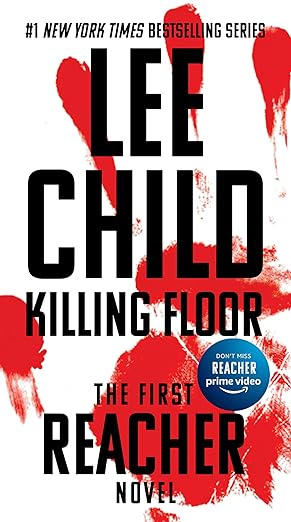INK & GRIT: Masters of Pulp Fiction - The Lee Child Edition
Editor’s Note:
If you missed the early parts of the INK & GRIT series you can catch up below.
START HERE
THE SERIES CONTINUES HERE:
This Fiction Business By H. Bedford-Jones: A Book Review
A Million Words a Year For Ten Years Straight - Walter B. Gibson
Quantity Production - Arthur J. Burks
Max Brand: 30 Million Words of Fiction - Part I
The INK & GRIT: Masters of Pulp Fiction series takes a slight detour outside of the time of the pulp era into our present day to highlight mainstream writer who extols the virtues of yesteryears pulp fictioneer.
From commercial television to commercial fiction, he’s a bestselling author who really needs no introduction. Penning over 30 books, Lee Child is the creator of the Jack Reacher series that has sold over 60 million copies world-wide.
I picked up a copy of the first Reacher novel Killing Floor some time ago at a routine trip to the grocery store. Reading page one of the introduction, I soon realized that I stumbled upon a storytelling masterclass for the price o $6.99.
Child discusses how he went from losing his job in commercial television to writing his way out of financial ruin.
The following quotes are taken from Child’s introduction to The Killing Floor.
"I worked for a commercial television station in Manchester, England. I was eleven years into a career as a presentation director…in February 1988, the UK commercial network had started twenty-four-hour broadcasting. For a year before that management had been talking about how to man the new expanded commitment. None of us really wanted to work nights. Management didn’t really want to hire extra people. End of story. Stalemate. Impasse.
What broke it was the offer of a huge raise. We took it, and by New Year’s Eve we were ten fat and happy months into the new contract…I was having a ball with the new salary. But I knew management resented the raise, and I knew that the new contract was in fact the beginning of the end. Sooner or later, we would all be fired in revenge.
I felt it was only a matter of time. No one agreed with me, except one woman. At the party, in a quiet moment, she asked me, “What are you going to do when this is all over?
I said, “I’m going to write books.”
Child goes on to discuss his reading habits and his insatiable appetite for thrillers, specifically devouring the Travis McGee novels by John D. MacDonald that became his instruction for writing compelling fiction.
“Nobody needs me to sing MacDonald’s praises, but that yard of [Travis McGee] books did more for me than provide excellent entertainment. For some reason the McGee books spoke to me like textbooks.
I felt like I could see what MacDonald was doing, and why, and how, as if I could see the skeleton beneath the skin.
I read them all that summer, and by New Year’s Eve I was completely sure that when the ax fell, I wanted to do what MacDonald had done.
I could stay in the entertainment business, but work for myself in the world of books.
After eventually losing his job, Child went to work on his writing equipped with $6 worth of legal pads, a pencil, eraser, and pencil sharpener. He recalls his early education in learning the classics, reading epic sagas, poetry, and myths and how it influenced his reading habits and his admiration for the Knight archetype that would later create his bestselling hero Jack Reacher.
Child goes on to discuss how important it was for him to respect the audience. He reflects on his time working in the theater where certain people expressed distain and contempt for paying audiences who were not moved by their failed experimental productions.
“The worst was run by people who saw their minimal audiences as badges of honor. ‘The public is too stupid to understand us,’ they would say. I hated this attitude.
To me, entertainment was a transaction. You do it, they watch it, then it exists. Like a Zen question: If you put on a show, and nobody comes, have you in fact put on a show at all? So for me, the audience mattered from the start.
G.K Chesterton once said of Charles Dickens, ‘Dickens didn’t write what people wanted. Dickens wanted what people wanted.’ I would never compare myself to Charles Dickens, but I know exactly what Chesterton meant.”
He continues to breakdown his approach to developing the Reacher books, starting with one principle ingredient: A compelling character.
“First: “Character is king. There are probably fewer than six books every century remembered specifically for their plots. People remember characters. Same with television. Who remembers the Lone Ranger? Everybody. Who remembers any actual Lone Ranger story lines? Nobody.
So, my lead character had to carry the whole weight….and there was a lot of weight to carry. Remember, I was broke and out of work.
Through the pages of this introduction, Lee Child demonstrates his tenacity to make it out as a writer and his meticulous attention to detail in order to create a memorable character in a series of exciting novels. I recommend picking up the mass market paperback copy of Killing Floor. The rest of the introduction is worth its weight in gold.
Another interview I highly recommend “The man with no plot: how I watched Lee Child write a Jack Reacher book”. Very educational.
“Even before he had written the first sentence, he turned to me and said: “This is not the first draft, you know”. “Oh - what is it then?” I asked naively. “It’s the ONLY DRAFT!” he replied, with definite upper case or at least italics in his voice. He didn’t want to change anything, so neither could I.
Hence it took me several months to work out why it was that he worked in this fundamentally terrifying, angst-inducing way. Actually several explanations have occurred to me: sloth for one. He just can’t be bothered. And then there is what he says, which is that he would be “bored” if he knew what was coming next. But contained in that statement is a hint of what I think is the case and in fact is the secret of his whole writing.
Lee Child writes his books as if he were the reader not the writer. When he is sitting at his desk in that back room in Manhattan he is only typing. The real work takes place when he is “dreaming”, when he is being just another reader, wondering what is coming next, waiting to find out. It probably explains too why he allowed me to look over his shoulder and watch his sentences taking shape even before he knew how they would end. He feels a natural sympathy with readers because he is one.”
- From “The man with no plot: how I watched Lee Child write a Jack Reacher book”
“INK & GRIT: Masters of Pulp Fiction” is a series dedicated to exploring the history and respected careers of the pulp writers from the 1920s to the 1950s. Follow along future installments as we dive deep into the world of cheap thrills and take a closer look of the men and women who made a name (and living) for themselves.







I sent off (to Walmart - free 2-day shipping - and got a copy of Lee Child's Killing Floor, hoping it was the mass media version - and it was. Once I got it, I put off my other schedule for the day to scan and OCR it to read and savor that introduction. (Their text was tiny.)
Child says quite a bit about the how and why of building a character, particularly Reacher.
I'd separately gotten a copy of Walter Gibson's article and see how he (roughly) said that the hero is the plot. These two write-ups tend to expand on each other.
A third reference I had was from Foster Harris, in his Formulas of Fiction, where he points out that you "can't separate the character from his plot problems" (He helped run the OU Professional Writing program during the Golden Age of Pulp Magazines.)
These three seem to go in the same direction - that the reader wants you to tell the story through the eyes and senses of the main VP character - so that reader can immerse themselves thoroughly.
I picked up a book he edited "How to Write a Mystery", but haven't read it yet. The more I hear about him, the more interested in his writing I am. I did love the movies and the tv series based on his books.
So, I have a question:
Is there such a thing as a "cozy thriller"?
i.e. - can you write thrillers without all the cussing and graphic stuff? Or is that what really makes it a thriller? Or mystery?
I know there are heist movies that aren't based on murder, that are still thriller.
I guess I'm just not sure what qualifies as each of those genre?
Like:
"The Transporter"
"The Italian Job"
"Leverage" (Original)
"White Collar"
"Jack Reacher"
"The Mentalist"
"Lie to Me"
"The Listener"
"Criminal Minds"
"Swat"
"Bones"
"The Pretender"
"Murdock"
"The Destroyer"
Early "Blacklist"
These are all ones that I liked/like, but I don't know how they are separated, for if I wanted to write something like them (Okay, I am writing something like them, that is kind of Cop and Consultant based, but don't know what that is called, either.)
Thanks.